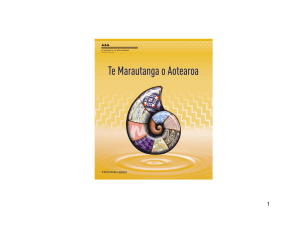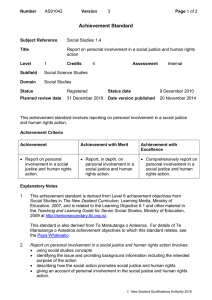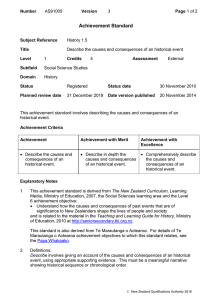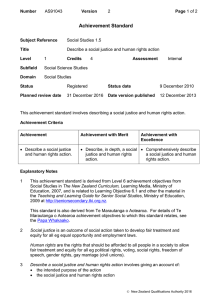Te Marautanga o Aotearoa
advertisement
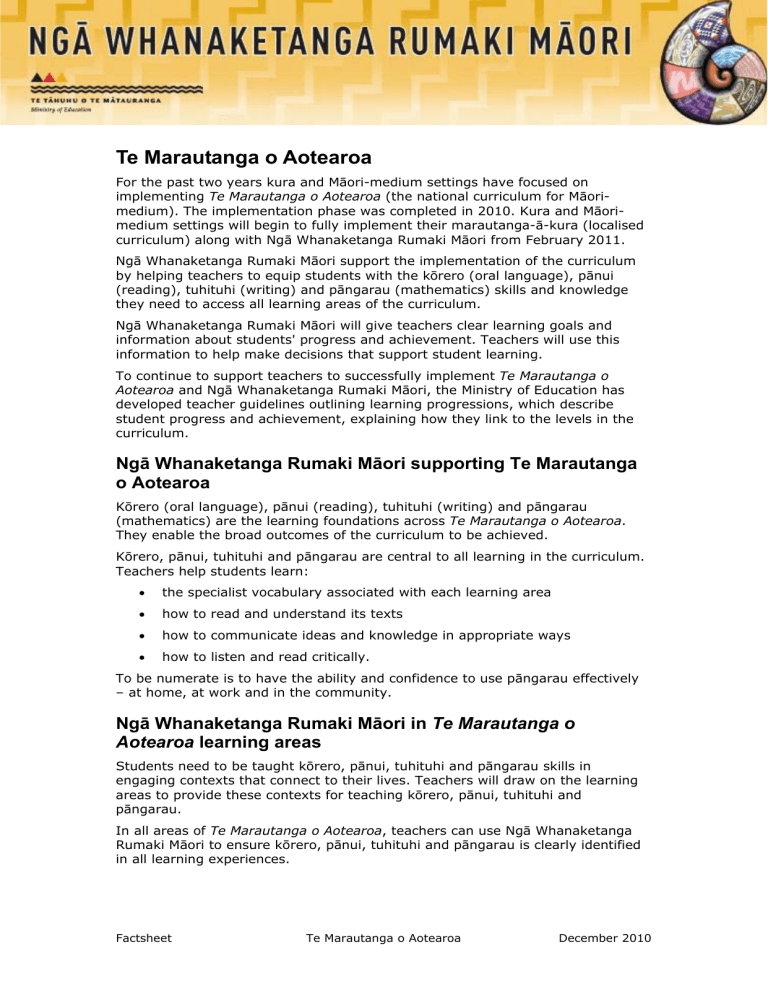
Te Marautanga o Aotearoa For the past two years kura and Māori-medium settings have focused on implementing Te Marautanga o Aotearoa (the national curriculum for Māorimedium). The implementation phase was completed in 2010. Kura and Māorimedium settings will begin to fully implement their marautanga-ā-kura (localised curriculum) along with Ngā Whanaketanga Rumaki Māori from February 2011. Ngā Whanaketanga Rumaki Māori support the implementation of the curriculum by helping teachers to equip students with the kōrero (oral language), pānui (reading), tuhituhi (writing) and pāngarau (mathematics) skills and knowledge they need to access all learning areas of the curriculum. Ngā Whanaketanga Rumaki Māori will give teachers clear learning goals and information about students' progress and achievement. Teachers will use this information to help make decisions that support student learning. To continue to support teachers to successfully implement Te Marautanga o Aotearoa and Ngā Whanaketanga Rumaki Māori, the Ministry of Education has developed teacher guidelines outlining learning progressions, which describe student progress and achievement, explaining how they link to the levels in the curriculum. Ngā Whanaketanga Rumaki Māori supporting Te Marautanga o Aotearoa Kōrero (oral language), pānui (reading), tuhituhi (writing) and pāngarau (mathematics) are the learning foundations across Te Marautanga o Aotearoa. They enable the broad outcomes of the curriculum to be achieved. Kōrero, pānui, tuhituhi and pāngarau are central to all learning in the curriculum. Teachers help students learn: • the specialist vocabulary associated with each learning area • how to read and understand its texts • how to communicate ideas and knowledge in appropriate ways • how to listen and read critically. To be numerate is to have the ability and confidence to use pāngarau effectively – at home, at work and in the community. Ngā Whanaketanga Rumaki Māori in Te Marautanga o Aotearoa learning areas Students need to be taught kōrero, pānui, tuhituhi and pāngarau skills in engaging contexts that connect to their lives. Teachers will draw on the learning areas to provide these contexts for teaching kōrero, pānui, tuhituhi and pāngarau. In all areas of Te Marautanga o Aotearoa, teachers can use Ngā Whanaketanga Rumaki Māori to ensure kōrero, pānui, tuhituhi and pāngarau is clearly identified in all learning experiences. Factsheet Te Marautanga o Aotearoa December 2010 Ngā Whanaketanga Rumaki Māori and implementing Te Marautanga o Aotearoa Teachers can support students to attain Ngā Whanaketanga Rumaki Māori in kōrero, pānui, tuhituhi and pāngarau. This happens when teachers: • create a supportive learning environment • encourage reflective thought and action • enhance the relevance of new learning (so students know what they are learning and what is expected, why they are learning it and how they will be able to use their new learning) • facilitate shared learning so all learners and their communities discuss and provide challenge, support and feedback • make connections to prior learning and experience • provide sufficient opportunities to learn, so students can practice, get better at and transfer new learning • inquire into the teaching–learning relationship, using evidence of student engagement and achievement to make decisions about the curriculum choices and what and how to teach. Students who are engaged in, and who understand and value their learning, will have a greater sense of control of their learning. This is likely to affect their effort and achievement. Kōrero, pānui, tuhituhi and pāngarau skills and knowledge can be valued as keys to learning in varied and relevant contexts. As schools develop their own marautanga-ā-kura using Te Marautanga o Aotearoa, they will need to consider how every teacher can identify the kōrero, pānui, tuhituhi and pāngarau learning opportunities and demands in every learning area – and in the wider school context. Factsheet Te Marautanga o Aotearoa December 2010
